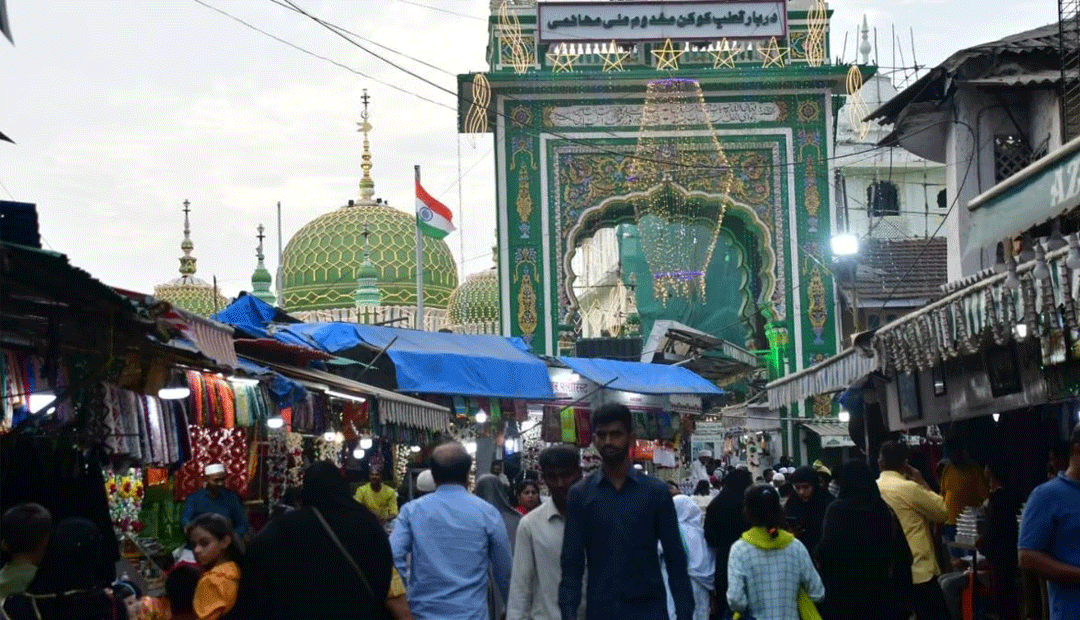Maharashtra
Prayers, Food, & Games: Lakhs Expected To Visit Mahim Fair That Starts Tomorrow

The 10-day annual fair at the dargah of Makhdum Ali Mahimi at Mahim will start on December 27 as it has always, with a procession of personnel from the Mahim police station walking to the shrine bearing gifts of a chadar, a shawl to cover the tomb, and scented offerings. The fair starts six days after the Urs, or the death anniversary of the saint which was observed last week.
The shrine of Makhdum Ali Mahimi
The shrine is revered as the tomb of a religious scholar believed to have lived between the fourteenth and fifteenth centuries. Stories of miraculous cures bring thousands of pilgrims to the dargah which is the city’s second-most-visited Sufi shrine after the Haji Ali dargah.The shrine observed the saint’s 610th death anniversary or Urs on December 21 which corresponded to the eighth day of the Islamic month Jamadul Akhir which began on December 14. The Urs began last week with the unfurling of the national flag and singing of the song ‘Sare jahan se acha’. This is followed by the raising of the flags of the police and the dargah.
Event is a ‘gazetted mela’
Sohail Khandwani, trustee of the Pir Makhdum Saheb Charitable Trust, said that the fair that takes place around the shrine during the Urs is a ‘gazetted mela’ as the event is listed in government gazettes from the pre-independence days. “The fair started in 1910, so this is the 113th year,” said Khandwani.
For a religious place, the shrine has an unusual feature – a copy of the preamble to the Constitution of India mounted on the wall near the Ashtana or the shrine’s inner sanctum which houses the saint’s tomb.
Mansoor Khan of the Sufi Islamic Board said that the idea behind placing the preamble’s copy is to show that no place in the country is untouched by the theme of nationalism. “As things are today, shrines are shown in a negative light. We have to show that there is no religious discrimination at this place. Dargahs are inclusive and embracers of national culture,” explained Khan.
More about ‘Mahim ka Mela’
Apart from the spiritual aspects of the festival, the ‘Mahim ka Mela’, organised like a carnival, is an attraction for visitors. As the number of visitors to the fair has grown, the event, which was once confined to the narrow Dargah Street, has shifted to Balamia Street and extends to Mahim Beach. More than five lakh people are expected to visit the fair.
Ashraf Ahmed Shaikh, a lawyer and resident of Mahim said, “It is like a traditional fair, with amusement rides. Shopkeepers come from all over India to sell different kinds of food. The main dish at the fair is ‘Halwa Paratha’. As kids we were excited about the fair,” said Shaikh.
There is no authentic record of how the Mumbai police became involved with the shrine’s annual festival, but it is said that personnel prayed to the saint when there was a particularly difficult crime case to be investigated. Other than the police, officials from the traffic police, the Brihahmumbai Municipal Corporation, and the Mumbai Port Trust are involved in managing traffic and stalls at the fair.
1st dargah trust to get an ISO certification in 2007
The shrine is the first dargah trust to get an ISO (International Organization for Standardization) certification in 2007 for management practices. The certificate has been renewed till July 2025. The certificate acknowledges the trust’s calibre in organising the Urs, the religious research it facilitates, and the library services charity activities of the trust.
The shrine houses a 600-year-old Quran believed to have been written by the saint. An annual exposition called the ‘Quran Sharief Ziyarat’ is held on a day in the month of Ramzan when the book is displayed to the faithful for a few hours. During the rest of the year, the book is kept in a silver box in the Ashtana. The shrine’s managers said that the book was stitched together a century ago with pages written by the saint.
Maharashtra
Abu Asim Azmi praised for introducing a bill against hate speeches and hate crimes, Muslim organizations called Abu Asim Azmi’s step commendable.

Mumbai: Leading Mumbai NGOs like OZ Seva Trust, Minara Masjid Trust, All India Ulema Board, Malik Liaquat Hussain Trust, National Uni-Ayush Activist Trust, Mumbai Central Association etc. today felicitated SP State President Abu Asim Azmi at Islam Gymkhana and appreciated his efforts to maintain unity and brotherhood in the society by respecting all religions in the Maharashtra Assembly. Azmi had introduced a bill in the Nagpur Assembly to enforce strict laws against religious hatred, blasphemy, prophets, religious leaders, and religious places, and hate speeches and hate crimes.
The event was organised at Islam Gymkhana, Mumbai. Addressing the event, Abu Asim Azmi said that nowadays hatred is being spread among the brothers by making objectionable or insulting inflammatory speeches against any religion, religious leader, religious book, religious place, Prophet Muhammad (PBUH). This poses a threat to peace and order. Therefore, we have presented this bill in the Legislative Assembly against those who insult any religion, religious leader, religious book, religious place, or Prophet. This bill proposes a penalty of imprisonment for up to 10 years and a fine of up to Rs 2 lakh for those who make slanderous statements about any religion, religious leader, religious book, or religious place or spread it on social media. Such a punishment will curb hate speech and hate crimes. MLA Raees Shaikh, State Working President Yousuf Abrani, Chief General Secretary Meeraj Siddiqui and Advocate Rizwan Merchant, Maulana Ijaz Kashmiri, Nizamuddin Rain, Naseem Siddiqui, Sarfaraz Arjo were present at the event.
Maharashtra
A split in Maha Vikas Aghadi before BMC elections, Congress’s slogan is ‘akela Chalo’

The trumpet of the municipal elections has sounded in the state. Voting for 29 municipal corporations will be held on January 15, while the counting of votes will be held on January 16 and the results will be announced. In this election, everyone’s attention will be focused on the Mumbai Municipal Corporation elections. The Shiv Sena Thackeray group will try to retain power in the Municipal Corporation. While Eknath Shinde’s Shiv Sena and BJP will try to rule the BMC in Mumbai. Negotiations on seat sharing are ongoing in Mahayoti, but the electoral understanding has not been completed yet. However, a major rift has arisen in the Maha Vikas Aghadi before the Mumbai Municipal Corporation elections. The Congress has announced to fight the Mumbai Municipal Corporation elections on its own. Due to which the competition in this election has intensified further.
Congress will fight the elections alone
Congress has announced to fight the Mumbai Municipal Corporation elections on its own. Congress’ Maharashtra in-charge Ramesh Chinnathala is currently on a visit to Maharashtra. After a meeting held in Mumbai today, Ramesh Chinnathala has said that he will fight the upcoming elections on his own. He said that there is a lot of corruption in Mumbai. That is why the Congress has decided to fight the elections alone. We have decided to fight against the BJP and the Shiv Sena Thackeray group. True patriots and secular people should support us in this fight. After coming to power, we will resolve the issues of the Mumbai Municipal Corporation in a good way. Therefore, I appeal to the voters to support us and we will develop Mumbai.
Mumbai Municipal Corporation Elections
The State Election Commission had announced the Mumbai Municipal Corporation elections in a press conference on December 15. According to this announcement, candidates will be able to file their applications from December 23 to December 30, 2025. The Election Commission will scrutinize the applications on December 31. Candidates can withdraw their applications till January 2, 2026. Voting for the Mumbai Municipal Corporation elections will be held on January 5. The voting will be held on January 16, 2026 and the results will be declared on the same day.
Maharashtra
After Babri, it’s Kashi Mathura’s turn. Baba Bageshwar Dham’s provocation in Mumbai.

Mumbai: After the Babri Masjid, now it is Kashi Mathura’s turn, the slogan and provocation has been given by Dhirendra Shastri Bageshwar Dham Baba here in Mumbai. While answering the question of journalists in Andheri, Bageshwar Dham said that the temple is ours and we cannot give it up. When Baba was asked that the dispute had ended after the Babri Masjid, then why is the process of finding temples in mosques going on, to which he said that there are temples in many places and the dispute here is old. On Hindu Rashtra, Bageshwar Dham made it clear that there is also room for Muslims in Hindu Rashtra, his aim is to strengthen Sanatan, while a pilgrimage for Hindu Rashtra will start in Maharashtra to promote Hindutva. He said that it is wrong to declare India a secular country because India has never been secular. He said that there is a need for brotherhood and unity in this country and for that he goes on pilgrimage. Baba, while spewing venom, said that if efforts are not made for Hindu Rashtra and Hindus are not united, then the time is not far when the invasion of India will take place. He said that highly educated doctors in the country are becoming terrorists. If there is a Hindu Rashtra, then a Muslim youth will become Abdul Kalam. Will the mayor of Mumbai be a Muslim or a Hindu? On this, Bageshwar Dham said that he is away from politics, so a candidate should be selected who is useful for the people.
-

 Crime3 years ago
Crime3 years agoClass 10 student jumps to death in Jaipur
-

 Maharashtra1 year ago
Maharashtra1 year agoMumbai Local Train Update: Central Railway’s New Timetable Comes Into Effect; Check Full List Of Revised Timings & Stations
-

 Maharashtra1 year ago
Maharashtra1 year agoMumbai To Go Toll-Free Tonight! Maharashtra Govt Announces Complete Toll Waiver For Light Motor Vehicles At All 5 Entry Points Of City
-

 Maharashtra1 year ago
Maharashtra1 year agoFalse photo of Imtiaz Jaleel’s rally, exposing the fooling conspiracy
-

 National News1 year ago
National News1 year agoMinistry of Railways rolls out Special Drive 4.0 with focus on digitisation, cleanliness, inclusiveness and grievance redressal
-

 Maharashtra1 year ago
Maharashtra1 year agoMaharashtra Elections 2024: Mumbai Metro & BEST Services Extended Till Midnight On Voting Day
-

 National News1 year ago
National News1 year agoJ&K: 4 Jawans Killed, 28 Injured After Bus Carrying BSF Personnel For Poll Duty Falls Into Gorge In Budgam; Terrifying Visuals Surface
-

 Crime1 year ago
Crime1 year agoBaba Siddique Murder: Mumbai Police Unable To Get Lawrence Bishnoi Custody Due To Home Ministry Order, Says Report
















